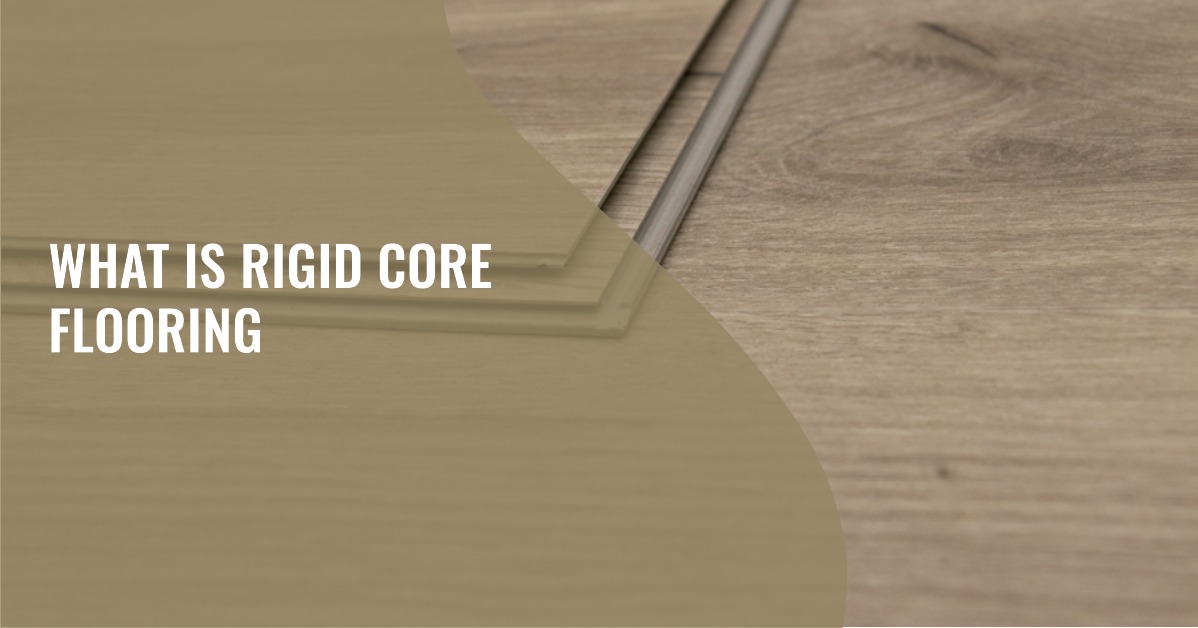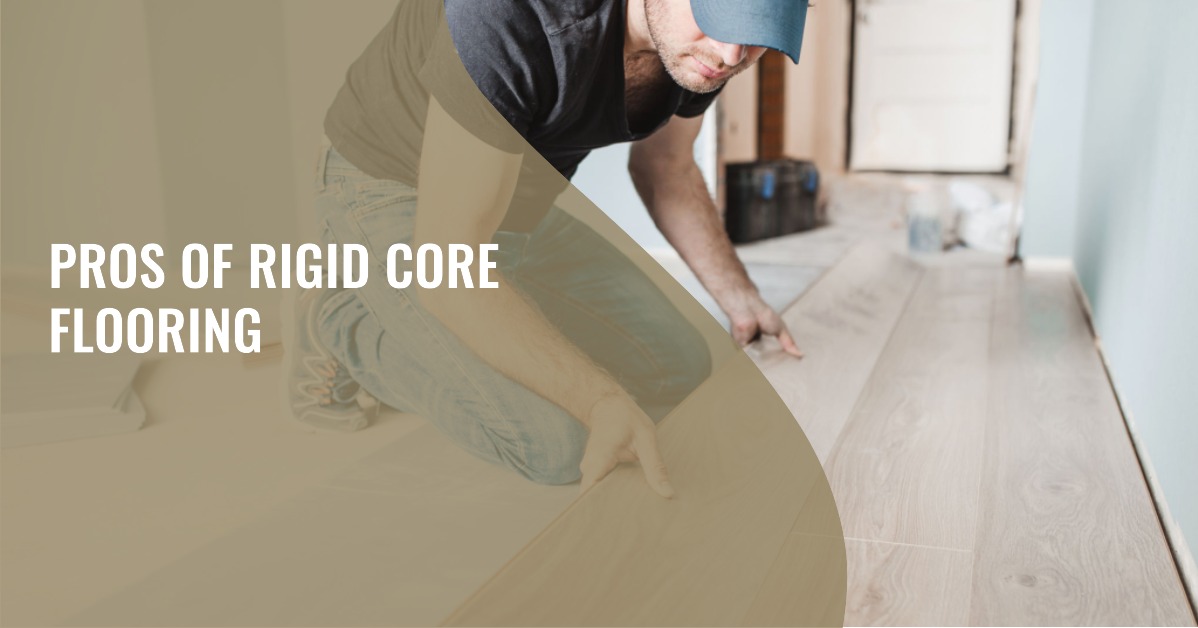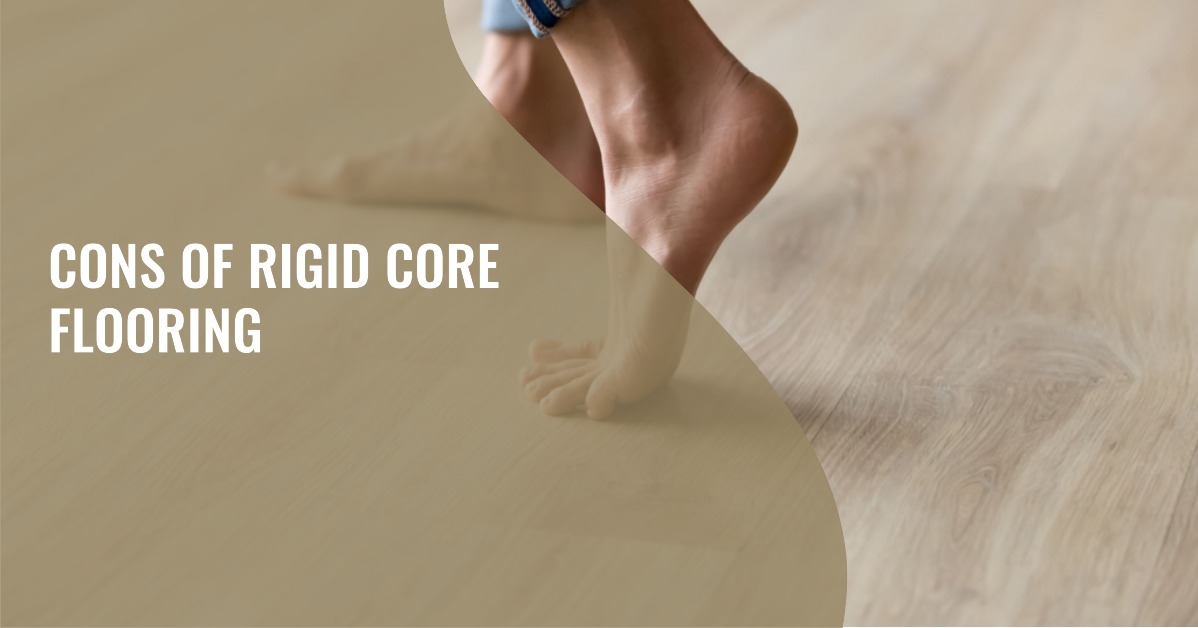If you are searching for a wood or tile effect flooring solution that is exceptionally strong and closely mimics the appearance of natural flooring, rigid core flooring ought to be high on your list. At Wood and Beyond, with over 15 years of experience in selling hard flooring solutions, we have observed a significant increase in both commercial and residential properties choosing rigid core flooring. In this impartial guide, we will illuminate the advantages and, indeed, the drawbacks of this type of flooring.
What Is Rigid Core Flooring

The multi-layer of wear, design, core and baking results in a Rigid Core Flooring
Rigid core flooring, often referred to within the industry as Stone Plastic Composite (SPC) or Wood Plastic Composite (WPC) flooring, represents an advanced synthesis of flooring technology, distinguished by its robust core layer that confers unparalleled dimensional stability and durability.
At its essence, the rigid core is composed of a mixture of polyvinyl chloride (PVC), plasticisers, and natural limestone powder, fortified with stabilisers and other composite materials. This concoction is then subjected to high-temperature extrusion processes that meld these components into a dense, impervious core. The core’s density is crucial; it not only imparts structural rigidity that resists indentation and warping but also provides a substantive feel underfoot, akin to traditional hardwood or stone flooring.
Overlaying this core, a high-definition photographic layer is applied, which bestows the flooring with its realistic wood or stone aesthetic. This imagery is meticulously chosen to encapsulate the nuances and variegations found in natural materials, delivering a visual fidelity that rivals real hardwood or stone surfaces.
A transparent wear layer crowns the photographic film, providing the first line of defense against abrasions, scuffs, and stains. This layer is commonly enhanced with ceramic bead, quartz, or other mineral constituents, significantly amplifying its resistance to wear and tear, and thereby elongating the lifespan of the flooring.
The uppermost layer is typically a UV-cured urethane coating, which not only fortifies the wear layer but also delivers low-maintenance properties, making the flooring easy to clean and less prone to discolouration over time.
Finally, many rigid core flooring products are equipped with an underlying acoustic pad, typically made of IXPE (Irradiated Cross-linked Polyethylene) or EVA (Ethylene Vinyl Acetate). This padding enhances the floor’s sound dampening qualities and adds an additional layer of comfort, while also aiding in smoothing out minor subfloor imperfections.
This technically advanced structure of rigid core flooring, through its composition and manufacturing process, establishes it as a frontrunner in the realm of high-performance flooring, offering a unique blend of durability, visual appeal, and ease of installation that is particularly suited to both residential and commercial applications.
Pros vs. Cons of Rigid Core Flooring at a Glance
| Pros of Rigid Core Flooring | Cons of Rigid Core Flooring |
|---|---|
| Durability: Suited for heavy traffic and loads. | Price: More expensive than laminate or linoleum. |
| Water Resistance: Ideal for wet areas in the home. | Installation: Non-click fit requires professional installation. |
| Style Variety: Wide range of designs available. | Comfort: Less cushioning underfoot without underlay. |
| Acoustic Benefits: Vinyl material dampens sound. | Durability (Comparison): Shorter lifespan than some wood floors. |
| Long Warranties: Reflects product durability. | Repair: Wear layer is difficult to repair compared to wood. |
| Easy Installation: Click and lock design for DIY. | |
| Underfloor Heating Compatible: Doesn’t warp with temperature changes. | |
| Versatile Application: Suitable for basements and conservatories. |
In-depth Pros of Rigid Core Flooring

Super easy installation when click fit is used is a major benefit
Durability: Initially a staple in commercial environments due to its robustness, rigid core flooring is able to withstand heavy foot traffic and significant loads without compromising on integrity or appearance. This has led to its adoption in homes where a long-lasting floor is a priority, ensuring a maximum lifespan even under strenuous conditions.
Water Resistance: A key advantage over options like engineered wood and laminate, the tight interlocking (click-fit) system of rigid core flooring provides an excellent seal against moisture. This characteristic makes it ideal for use throughout the house, including in areas prone to water exposure, such as kitchens and bathrooms, giving it a significant edge as a whole-home flooring solution.
Diverse Styles: With the rise in popularity of rigid core flooring, manufacturers have expanded their offerings to include an array of colours, textures, and patterns. Options now encompass planks, tiles, and intricate laying patterns such as herringbone and chevron, allowing for a high degree of personalisation to match any interior design theme.
Acoustic Properties: The composition of rigid core flooring, including its vinyl content, naturally dampens sound. This feature is particularly desirable as it helps to quieten footsteps and ambient noise, contributing to a more serene home environment.
Extended Warranties: Reflective of its durability, rigid core flooring often comes with lengthy warranties. These guarantees provide additional reassurance and peace of mind regarding the longevity and performance of the flooring.
Ease of Installation: The click-and-lock design facilitates ease of installation, making it a viable project for the proficient DIY enthusiast. This user-friendly system can reduce installation time and costs, a considerable pro for those seeking a straightforward flooring upgrade.
Compatibility with Underfloor Heating: Rigid core’s synthetic makeup renders it resistant to temperature variations, making it an optimal choice for installation over underfloor heating systems. With a conducive thickness range of 4mm to 8mm, these floorboards allow efficient heat transfer, ensuring a warm and comfortable surface underfoot.
Suitability for Challenging Environments: Finally, rigid core flooring transcends the limitations that often exclude other flooring types from certain areas of the home. It is suitable for basements, conservatories, and other spaces that may experience extremes of temperature, humidity, or dampness—conditions that would typically compromise the integrity of many traditional flooring options.
In essence, rigid core flooring is a comprehensive flooring solution that meets a vast array of needs with resilience, style, and practicality.
In-depth Cons of Rigid Core Flooring

The rigid nature of the floor can be uncomfortable underfoot
Price: Rigid core flooring, despite being less expensive than high-end options like engineered wood, still presents a costlier alternative compared to other synthetic flooring types such as standard PVC core materials, laminate, or linoleum. This increased cost can be a deciding factor for budget-conscious consumers.
Installation Complexities: Non-click fit versions of rigid core flooring necessitate a more laborious installation process involving special adhesives and tools. This method typically demands professional fitting, which can increase overall costs and is not as DIY-friendly as click-fit systems.
Comfort Underfoot: The very feature that gives rigid core flooring its durability—the rigid core—can also result in a firmer feel underfoot, which some may find less comfortable. While an underlay can offer some cushioning, it does not impart the same softness as other softer, more pliant materials.
Comparative Durability: Though a lifespan of 15 to 25 years is commendable, rigid core flooring may not endure as long as high-quality engineered wood or solid wood floors. For those seeking a flooring solution to last a lifetime, rigid core may not measure up to these more traditional materials.
Repair and Maintenance: The wear layer that protects rigid core flooring is both a blessing and a curse. While it offers a sturdy barrier against wear and external elements, if damaged, it is not as easily repaired as wood flooring. Wood can often be sanded down and refinished to address wear or damage, but once the wear layer of rigid core flooring is compromised, repair options are limited.
Very Little Comes Close To Rigid Core Flooring
Rigid core flooring, with its impressive array of benefits, firmly positions itself as a premier choice in the flooring market. Its remarkable durability and resistance to water make it suitable for every space within the home or commercial setting. The plethora of styles and textures available ensures there is a fit for every taste and interior design.
The quiet and comfort it offers, along with the compatibility with underfloor heating systems, add to its allure. While there are some considerations to bear in mind, such as cost and the nuances of installation and repair, the advantages of rigid core flooring often overshadow these concerns.
In essence, when the full spectrum of its characteristics is considered, it’s evident that very little comes close to rigid core flooring as a comprehensive and forward-thinking choice for modern living environments.
—
FAQ
What exactly is rigid core flooring?
Rigid core flooring, encompassing Stone Plastic Composite (SPC) and Wood Plastic Composite (WPC), is a highly durable flooring material with a core composed of PVC, limestone powder, and stabilisers. It is renowned for its stability, resistance to wear, and the ability to mimic natural flooring finishes.
How does rigid core flooring handle water exposure?
Thanks to its tightly locking joints, rigid core flooring offers excellent water resistance, making it suitable for use in moisture-prone areas of a property, such as kitchens, bathrooms, and utility areas, outperforming traditional wood-based flooring in this regard.
Can rigid core flooring be used with underfloor heating?
Yes, rigid core flooring is engineered to be compatible with underfloor heating systems up to 26c. Its structure does not warp with temperature fluctuations, and its ideal thickness allows for efficient heat transfer, providing a warm surface with an even distribution of heat.
What styles are available with rigid core flooring?
The popularity of rigid core flooring has led manufacturers to offer a wide array of designs, including various colours, textures, and laying patterns. Whether you desire planks, tiles, herringbone, or chevron patterns, there is a style to suit every aesthetic preference.
What should be considered when installing rigid core flooring?
While the click-and-lock mechanism of some rigid core flooring options simplifies installation, potentially making it suitable for DIY, non-click variants require professional fitting using special adhesives and tools, which can be more complex and costly.








